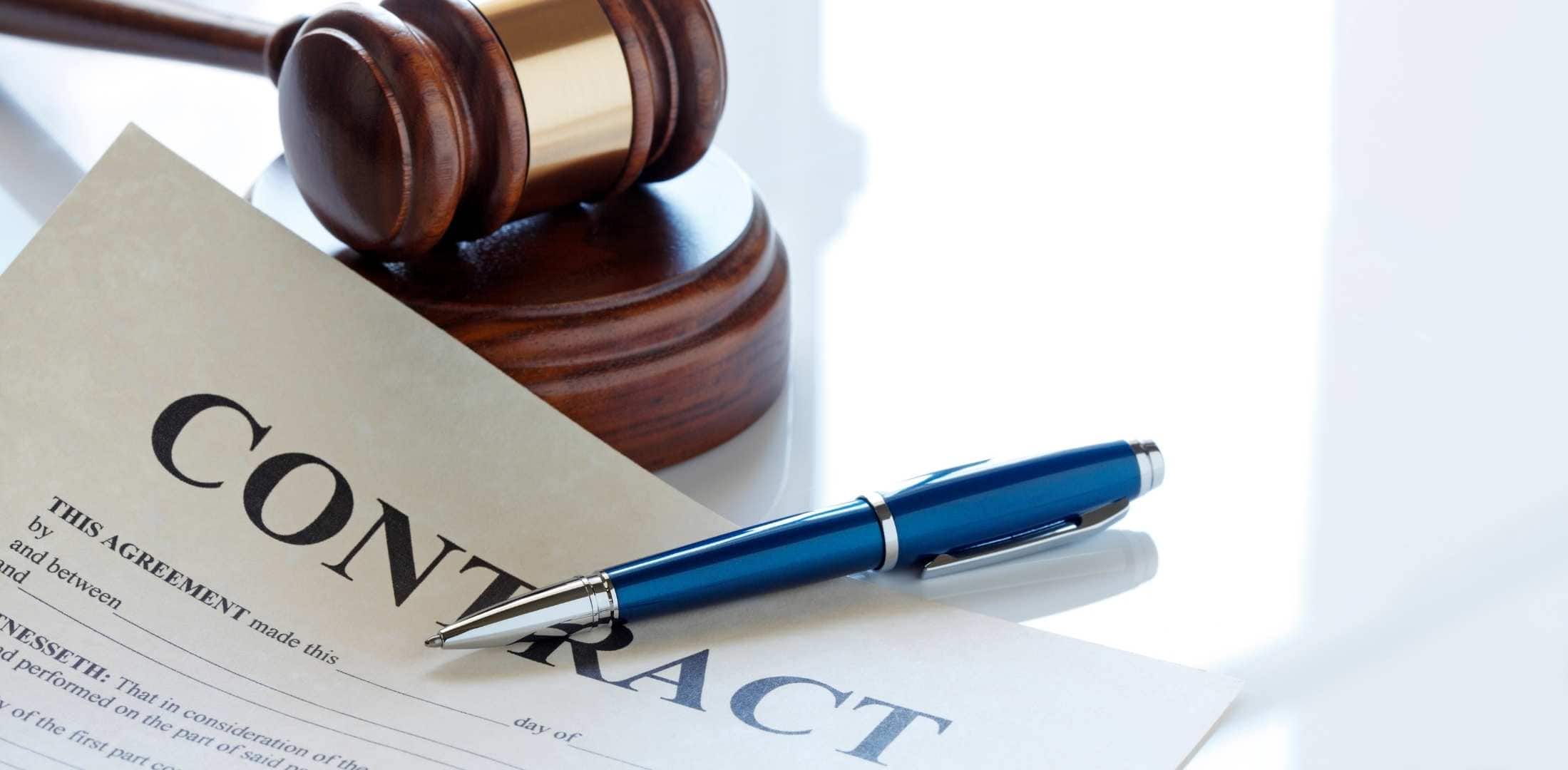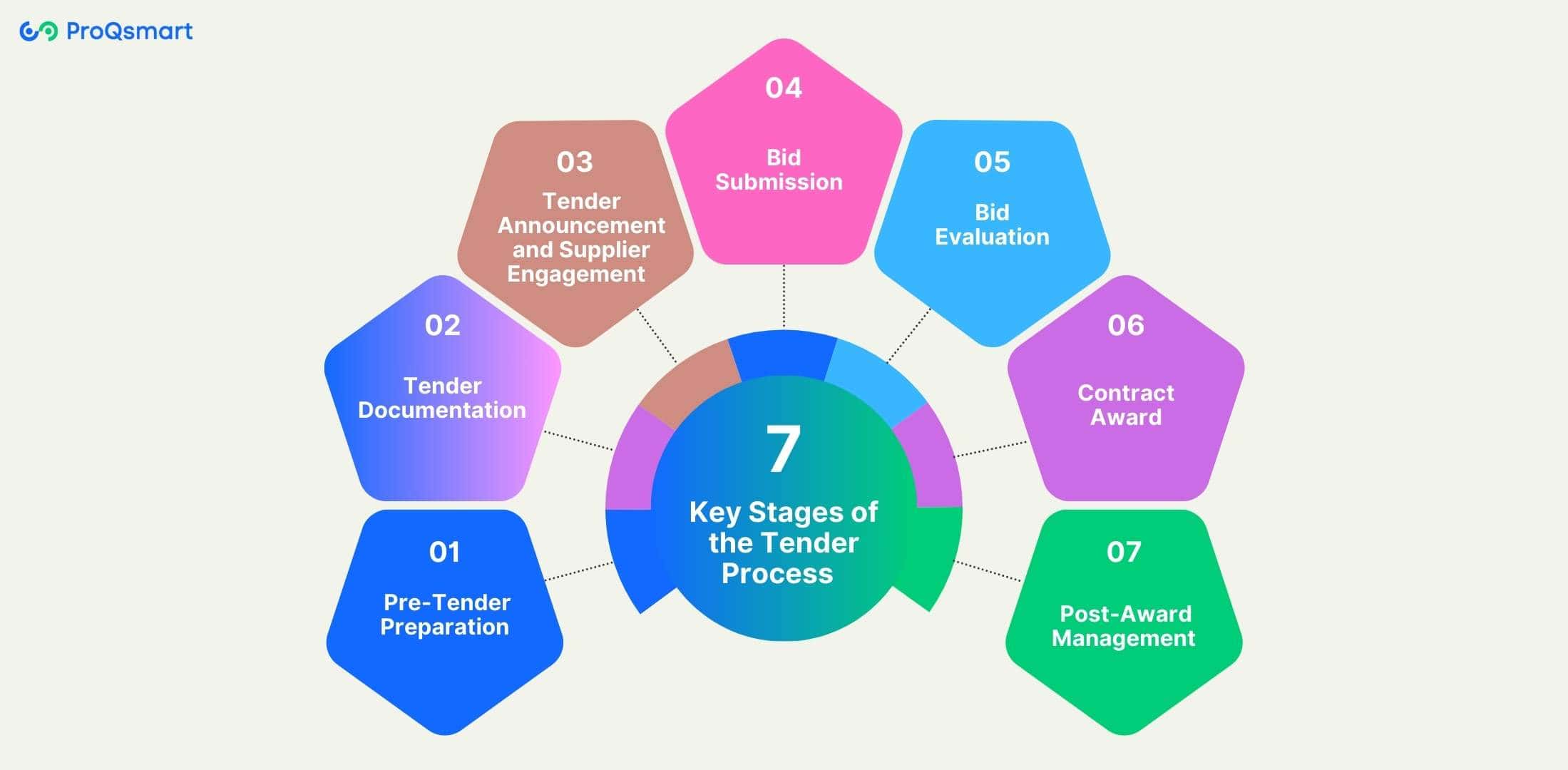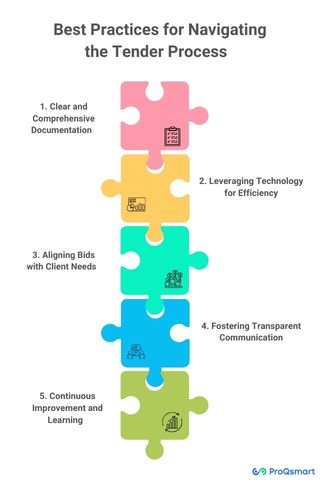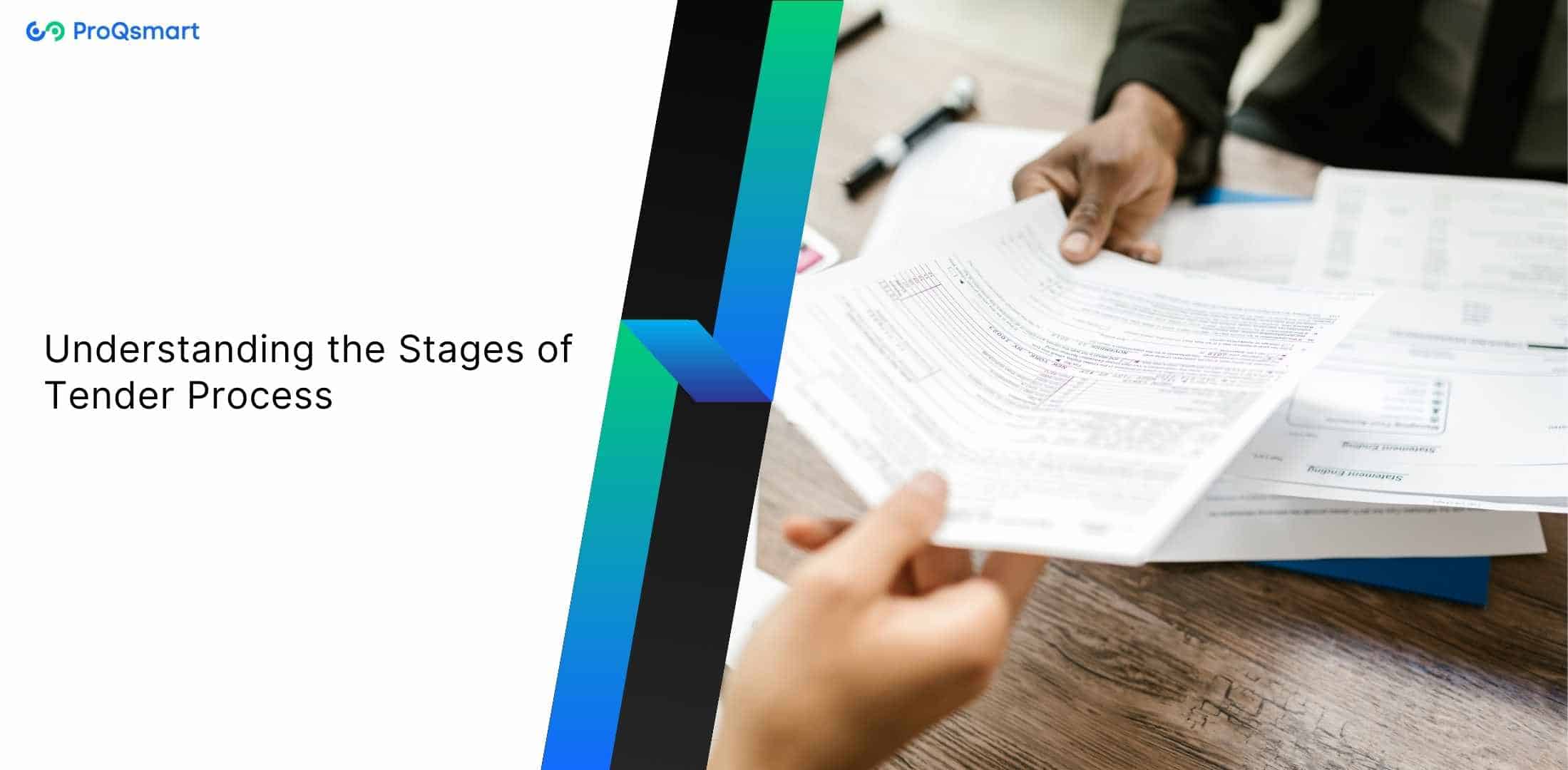Key Takeaways
Knowledge of the tender process is the key to success for any business looking to thrive in highly competitive environments. It promotes open and effective competition, transparency, and fairness while providing maximum value for money in procurement activities.
The tender process consists of seven key stages. These phases include Pre-tender preparation, Tender documentation, Tender announcement, Bid submission, Evaluation, Contract award and Post-award management. Each phase is equally important in the pursuit of smart procurement.
Good pre-tender preparation starts with in-depth market research. It requires a clear definition of project needs and making decisions with purpose that support overall organizational priorities.
Well prepared tender documentation with all required elements, such as RFPs(Request for Proposal) and ITTs (Invitation to Tender). By following this guidance, bidders can ensure they are meeting regulatory requirements, minimizing confusion, and increasing the competitiveness of their bids.
Incorporating technology such as e-sourcing platforms further enhances the tendering process. It shortens time to award, broadens supplier participation, and provides data-rich insights that enable agencies to make more informed decisions.
The tender process is usually fraught with issues such as lack of transparency, complexity, and supplier fatigue. You can surmount these barriers by adopting concrete measures, such as automation tools, robust evaluation frameworks, and continued education for your procurement staff.
What Is the Tender Process?

The tender process is a competitive and structured process that governs how suppliers or contractors are chosen by soliciting competing bids. This straightforward, organized process is designed to maximize transparency and fairness to give businesses all the information they need to select the best options based on price and quality. The tendering process is all about encouraging healthy competition.
“Its objectives are to reduce risks and guarantee that you receive the maximum value for your contracts.” Businesses need to understand this process in order to be successful in increasingly competitive markets. In fact, it goes to the heart of their operational efficiency and cost-effectiveness.
Key Stages of the Tender Process


Stage 1: Pre-Tender Preparation
Market research is vital to grasp supplier capabilities and market conditions, setting the foundation for a successful tender. Defining project scope, objectives, and budget during the needs assessment phase is crucial.
The Bid/No-Bid decision hinges on strategic alignment and resource availability. Critical activities in this phase include defining clear project specifications and assembling a skilled procurement team.
A checklist of essential tasks ensures thorough preparation.
Stage 2: Tender Documentation
Well written and detailed tender documentation is key. Key documents such as the Request for Proposal (RFP) and Invitation to Tender (ITT) lead the process.
Complying with these regulations and adopting a set of evaluation criteria that prioritizes the goals above them is essential. Clear and complete documentation minimizes confusion and increases the quality of received bids.
Other critical components are the specs and evaluation criteria. A simple comparison table of tender document types goes a long way in helping your potential contractor understand.
Stage 3: Tender Announcement and Supplier Engagement
With the documents ready, the next step is to announce the tender and engage suppliers. Use procurement portals, industry networks, and digital platforms to advertise the tender and reach a wide pool of potential bidders. This increases competition and improves the quality of submissions. Additionally, conduct pre-qualification to assess supplier suitability.
Stage 4: Bid Submission
Suppliers then submit bids, responding to project specifications and detailing costs. It is especially important to meet all submission deadlines, because if the bid is even a minute late, it is disqualified.
Fulfilling tender requirements is extremely important. A comprehensive checklist of submission items helps avoid the “half-baked” submission.
Save yourself from major missteps such as submittals delivered at the 11th hour.
Stage 5: Bid Evaluation
The evaluation stage is where bids are assessed to select the best supplier. Use predefined evaluation criteria such as cost, quality, compliance, sustainability, and risk to ensure a fair and objective assessment. Implement weighted scoring systems to prioritize key criteria and eliminate bias. This structured approach ensures transparency and consistency in the selection process, helping you identify the most suitable partner.
Stage 6: Contract Award
After evaluation, the winning bidder is selected. This decision should be well-documented and justified to maintain transparency. The next step is negotiation, where final contract terms, conditions, and performance expectations are agreed upon. Addressing any gaps or concerns during this phase helps avoid disputes later and ensures a smooth start to the project.
Stage 7: Post-Award Management
The final stage focuses on managing the contract and learning from the process. Contract implementation involves monitoring supplier performance to ensure compliance with agreed terms. Regular check-ins and performance reviews help maintain quality and address issues early. After the project, conduct a lessons learned review to identify strengths, weaknesses, and areas for improvement. Use these insights to refine future tender processes and achieve better outcomes.
Common Challenges and How to Overcome Them
Navigating the tender process can often feel like solving a complex puzzle. The intricate details and stipulations in procurement documents can be overwhelming, leaving many professionals struggling to comprehend fully and comply with requirements.
One effective way to address this is by establishing clear internal guidelines. This ensures that bidding documents are user-friendly, consistent, and reusable, simplifying the process for both your team and suppliers.
Challenges like bias and supplier fatigue can undermine the fairness of evaluations. Implementing robust evaluation frameworks ensures objectivity, while automation tools can handle repetitive tasks, freeing up resources for strategic decision-making.
Risk management is another critical area, especially in today’s volatile environment.
Factors like fluctuating commodity prices, supply chain disruptions, and shifting trade policies can significantly impact procurement outcomes. Conducting thorough due diligence helps mitigate these risks and ensures resilience.
Procurement teams often operate in silos, disconnected from broader organizational goals. Breaking down these barriers through regular communication ensures procurement activities align with organizational strategies and future demands.
Investing in strategic training and providing access to data and resources empowers teams to engage suppliers more effectively. Understanding project details and aligning them with operational realities is key to successful supplier collaboration.
As procurement evolves into a more strategic function, leaders must identify and automate inefficient processes. Today’s procurement managers are not just cost controllers; they are strategic partners responsible for vendor relations, cost efficiency, and adapting to a dynamic labor market.
Overcoming these challenges requires a collaborative approach, combining clear procedures, automation, strategic alignment, and continuous improvement.
Key Strategies:
Develop clear procedures for document comprehension.
Leverage automation for efficiency.
Align procurement with organizational strategy.
Enhance training and resource allocation.
Best Practices for Navigating the Tender Process


Successfully navigating the tender process requires a strategic approach that balances preparation, transparency, and collaboration. Whether you’re a buyer or a supplier, adopting the right practices can transform tendering from a daunting task into a competitive advantage. Below, we explore key strategies to excel in the tender process.
1. Clear and Comprehensive Documentation
For buyers, the foundation of a successful tender lies in clear and detailed documentation. Well-prepared tender documents should outline specifications, evaluation criteria, and timelines in a way that eliminates ambiguity. This not only simplifies the process for suppliers but also ensures a fair and unbiased evaluation, which is critical for maintaining the integrity of the tender. Suppliers, on the other hand, must carefully review these documents to understand the requirements fully and avoid misunderstandings that could lead to costly errors.
2. Leveraging Technology for Efficiency
Technology plays a pivotal role in streamlining the tender process. Buyers can use e-sourcing platforms to centralize document management, improve communication, and automate repetitive tasks. This not only saves time but also reduces the risk of errors, allowing teams to focus on strategic decision-making. For suppliers, leveraging tools like data analytics and AI can help tailor bids to meet client needs more precisely, highlighting areas for value addition and differentiation.
Platforms like ProQsmart take this efficiency to the next level. With its intuitive interface and advanced features, ProQsmart simplifies tender management for buyers, enabling seamless document handling, real-time collaboration, and automated workflows.
3. Aligning Bids with Client Needs
For suppliers, success in the tender process hinges on a deep understanding of the client’s requirements. A well-prepared bid goes beyond pricing; it clearly articulates the supplier’s capabilities, past successes, and the unique value they bring to the table. Clarity is the key—any omissions or ambiguities can lead to misunderstandings or even breaches of contract. Similarly, suppliers must also be prepared to address potential risks, such as cost fluctuations or supply chain disruptions, and present mitigation strategies as part of their proposal.
4. Fostering Transparent Communication
Transparent communication is essential for building trust and ensuring a smooth tender process. Buyers should engage stakeholders early and often to ensure alignment between procurement activities and organizational goals. For suppliers, maintaining open lines of communication with the buyer is crucial for clarifying requirements and addressing concerns promptly. This collaborative approach significantly reduces the likelihood of disputes and also ensures that all parties are on the same page.
5. Continuous Improvement and Learning
The tender process is not a one-time event but an ongoing opportunity for improvement. After each tender, both buyers and suppliers should conduct a thorough review to identify what worked and what didn’t. For buyers, this might involve refining evaluation criteria or improving documentation. For suppliers, it could mean honing their proposal-writing skills or investing in better tools for bid preparation. By learning from each experience, organizations can also turn the tender process into a strategic advantage, driving better outcomes and building stronger partnerships.
The Role of Technology in Modern Tendering
Technology has fundamentally transformed the tender process, making it more efficient, transparent, and competitive. At its core, technology streamlines operations by automating repetitive tasks such as document management, bid submission, and evaluation. Platforms like ProQsmart centralize the entire tender process, enabling teams to track progress, ensure compliance, and reduce manual errors. This not only saves time but also allows procurement professionals to focus on strategic decision-making rather than administrative tasks.
Transparency:
Transparency is another critical area where technology shines. Digital platforms provide a clear, auditable trail of all activities, from bid submission to contract award. Blockchain technology takes this a step further by ensuring secure, tamper-proof records, which boosts trust and accountability among all parties involved. This level of transparency is also essential for maintaining the integrity of the tender process and building strong supplier relationships.
Supplier engagement has also been revolutionized by technology.
E-sourcing platforms open the process to a wider pool of suppliers, fostering greater competition and driving better pricing and terms. Suppliers can also easily access tender documents, submit bids, and receive feedback through user-friendly interfaces. This inclusivity not only benefits buyers but also empowers suppliers to participate more effectively in the tendering process.
Data-driven decision-making is another significant advantage of modern technology. AI and predictive analytics analyze historical data to identify trends, forecast demand, and also optimize procurement strategies. Real-time dashboards and reporting tools provide actionable insights, enabling organizations to make smarter, more informed decisions. This capability is also particularly valuable in today’s dynamic market environment, where agility and foresight are key to staying competitive.
Compliance and risk management are also enhanced through technology.
Automated workflows ensure adherence to regulatory requirements and internal policies, reducing the risk of non-compliance. Risk assessment tools help identify and mitigate potential issues early in the process, ensuring smoother project execution and minimizing disruptions.
Finally, technology drives significant cost and time savings.” By reducing manual effort and speeding up processes, organizations can lower operational costs and shorten lead times”. Efficient tender management minimizes delays, stock outs, and inefficiencies, ultimately delivering better value for money.
E-Tendering platforms/softwares like ProQsmart are at the forefront of this transformation, helping organizations turn their tender processes into strategic advantages.
The table below highlights this transition:
Aspect | Traditional Methods | Modern Technology-Driven Approaches |
Speed | Slow | Fast and Efficient |
Supplier Reach | Limited | Expanded through Digital Platforms |
Transparency | Low | High with Blockchain |
Data Analysis | Manual | Automated with Big Data |
Conclusion
While the tender process may seem daunting at first, it doesn’t have to be. With the right knowledge, tools, and strategies, it can become a powerful driver of efficiency and value for your organization. By understanding each stage of the process and adopting best practices, you can streamline operations, improve outcomes, and gain a competitive edge.
Platforms like ProQsmart simplify tender management, automate repetitive tasks, and provide actionable insights, enabling both buyers and suppliers to focus on what truly matters—delivering value.
As you implement these strategies, you’ll not only make procurement more efficient but also create sustainable value for your organization. Ready to take your procurement processes to the next level? Book a demo with ProQsmart today to see how it can revolutionize your tendering process and help you stay ahead of the competition.





